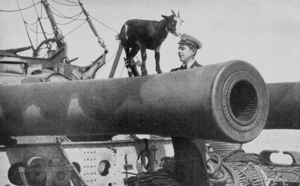BL 12 inch naval gun Mk VIII
| Ordnance BL 12 inch gun Mk VIII | |
|---|---|
|
Muzzle of gun on HMS Canopus, 1916 | |
| Type | Naval Gun, Coastal Defence |
| Place of origin | United Kingdom |
| Service history | |
| In service | 1895–1910s |
| Used by | Royal Navy |
| Wars | World War I |
| Production history | |
| Designer | Woolwich Arsenal |
| Manufacturer | Vickers |
| Variants | Mk VIII, VIIIe, VIIIv[1] |
| Specifications | |
| Weight | 46 tons barrel & breech[2] |
| Barrel length | 35 ft 5 in (10.80 m) (35.43 calibres)[2] |
|
| |
| Shell | 850 lb (390 kg)[2] |
| Calibre | 12-inch (304.8 mm) |
| Muzzle velocity | 2,367 ft/s (721 m/s)[3] |
| Effective firing range | 10,000 yd (9,100 m)[2] |
The BL 12 inch naval gun Mark VIII[note 1] was one of the first large British rifled breech-loading naval guns designed for the higher pressures generated by the new cordite propellant of the 1890s, and Britain's first large wire-wound gun. It represented a major advance compared to previous British guns.
Naval service
The gun was installed on the Majestic-class battleships from 1895 and on the Canopus-class battleships from 1899. During World War I guns removed from the obsolete Majestic class were mounted in Lord Clive-class monitors for shore bombardment.
Land service
From 1921 to 1926 two guns from the decommissioned battleship HMS Illustrious were in service in the Tyne Turrets for coast defence, north and south of the mouth of the River Tyne in the northeast of England.
Problems in service
During bombardment service when mounted in the Lord Clive-class monitors deposition of copper from the projectile driving bands needed frequent removal. However, problems with the inner liners were more serious. The continual drag of the driving bands caused the liner to be gradually stretched forward. The resulting protrusion at the muzzle could simply be cut off, but in addition the liner began to form a ridge in the barrel near the shoulders of the outer ‘A’ tube, where the inner ‘A’ tube was keyed to the outer. The ridge accumulated copper from the driving bands, which could give sufficient retardation to the projectile to start the fuze, which resulted in a premature detonation either within the bore, or soon after leaving the muzzle. This happened several times during bombardment service, including an occasion when Lord Clive showered pieces of shell over the French destroyer Aventurier. The ‘steel choke’ restriction could be temporarily removed by rubbing down with an emery-covered block pulled back and forth in the bore, but the only permanent cure was to fit new guns with a modified design of liner, which had a different arrangement of internal shoulders. [4]
Images
-

Y turret (aft) guns of HMS Hannibal.
-
_forward_guns.jpg)
Forward guns of HMS Ocean
-

HMS Canopus bombarding Turkish forts, Dardanelles March 1915. Photo by Ernest Brooks.
-
_firing_guns.jpg)
The battleship HMS Illustrious fires her 12-inch (305 mm) Mark VIII guns during gunnery practice.
-
_12-inch_gun.jpg)
The starboard 12-inch (305 mm) Mark VIII gun in one of the turrets aboard the battleship HMS Illustrious. The gun's breech is open.
-
_12-inch_gun.jpg)
The starboard 12-inch (305 mm) Mark VIII gun in one of the turrets aboard the British battleship HMS Caesar. The gun's breech is closed.
See also
Notes
- ↑ Mark VIII = Mark 8. Britain used Roman numerals to denote marks (models, abbreviated Mk) of ordnance until after World War II. Hence this was the 8th model of British 12-inch breech-loading naval guns,
References
- ↑ Mk VIII was the original Naval design; Mk VIIIe and VIIIv were reserve guns manufactured in 1906 by Elswick Ordnance and Vickers respectively. Hogg & Thurston 1972, page 190. These incorporated changes to correct a steel choke problem (DiGiulian)
- 1 2 3 4 Text Book of Gunnery 1902, Table XII Page 336
- ↑ 850 lb shell, with 174 lb cordite propellant. Text Book of Gunnery 1902, Table XII page 336
- ↑ Buxton, Ian (2008). Big Gun Monitors: Design, Construction and Operations, 1914–1945 (2 ed.). Seaforth Publishing, Pen and Sword Books Ltd, Sth Yorkshire S70 2AS, Great Britain. p. 224. ISBN 978-1-59114-045-0.
Bibliography
- Text Book of Gunnery, 1902. London: Printed for His Majesty's Stationery Office, by Harrison and Sons, St. Martin's Lane
- I. V. Hogg & L. F. Thurston, British Artillery Weapons & Ammunition 1914–1918. London: Ian Allan, 1972.
- Tony DiGiulian, British 12"/35 (30.5 cm) Mark VIII
External links
| Wikimedia Commons has media related to BL 12 inch Mk VIII naval gun. |
